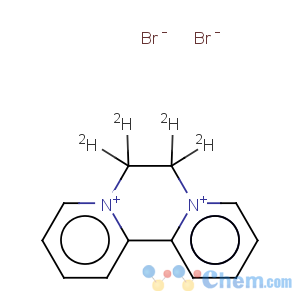Title: Diquat Dibromide
CAS Registry Number: 85-00-7
CAS Name: 6,7-Dihydrodipyrido[1,2-
a:2¢,1¢-
c]pyrazinediium dibromide
Synonyms: 1,1¢-ethylene-2,2¢-dipyridylium dibromide
Manufacturers' Codes: FB/2
Trademarks: Reglone (Syngenta)
Molecular Formula: C12H12Br2N2
Molecular Weight: 344.05
Percent Composition: C 41.89%, H 3.52%, Br 46.45%, N 8.14%
Literature References: Prepn: Fielden
et al., US 2823987 (1958 to ICI). Herbicidal properties: Brian
et al., Nature 181, 446 (1958). Environmental fate and toxicity: Simsiman
et al., Residue Rev. 62, 131-174 (1976). Acute toxicity study: T. B. Gaines, R. E. Linder,
Fundam. Appl. Toxicol. 7, 299 (1986).
Review: Akhavein, Linscott,
ibid. 23, 97-145 (1968).
Derivative Type: Monohydrate
CAS Registry Number: 6385-62-2
Properties: Pale yellow crystals from water, mp <320° (dec). Also reported as mp 335-340°. uv max: 308.31 nm (e 18000). Soly in water at 20°: 70%. Insoluble in organic solvents. Slightly sol in alcohol. Stable in acid or neutral soln. LD50 in male, female rats (mg/kg): 147, 121 orally; in male rats (mg/kg): 433 dermally (Gaines, Linder).
Melting point: mp <320° (dec); mp 335-340°
Absorption maximum: uv max: 308.31 nm (e 18000)
Toxicity data: LD50 in male, female rats (mg/kg): 147, 121 orally; in male rats (mg/kg): 433 dermally (Gaines, Linder)
CAUTION: Potential symptoms of overexposure are irritation of eyes, skin, mucous membranes, respiratory system; rhinorrhea, epistaxis; skin burns; nausea, vomiting, diarrhea, malaise; kidney and liver injury; cough, chest pain, dyspnea, pulmonary edema; tremor, convulsions; delayed wound healing.
See NIOSH Pocket Guide to Chemical Hazards (DHHS/NIOSH 97-140, 1997) p 122.
Use: Contact herbicide used also to produce desiccation and defoliation.

